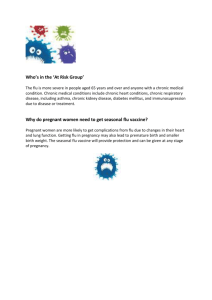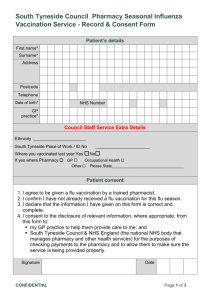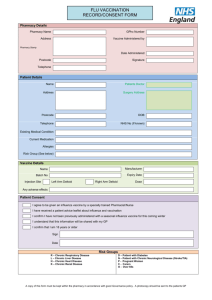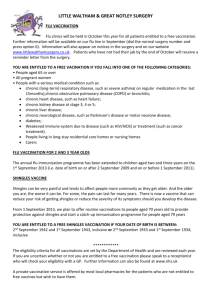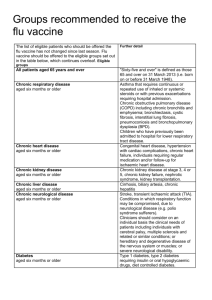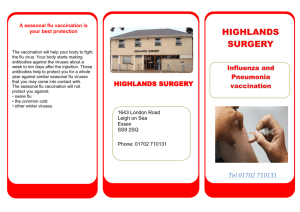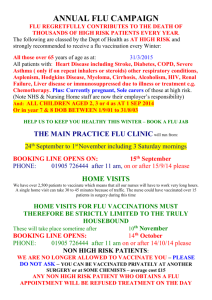Chronic Heart Disease
advertisement
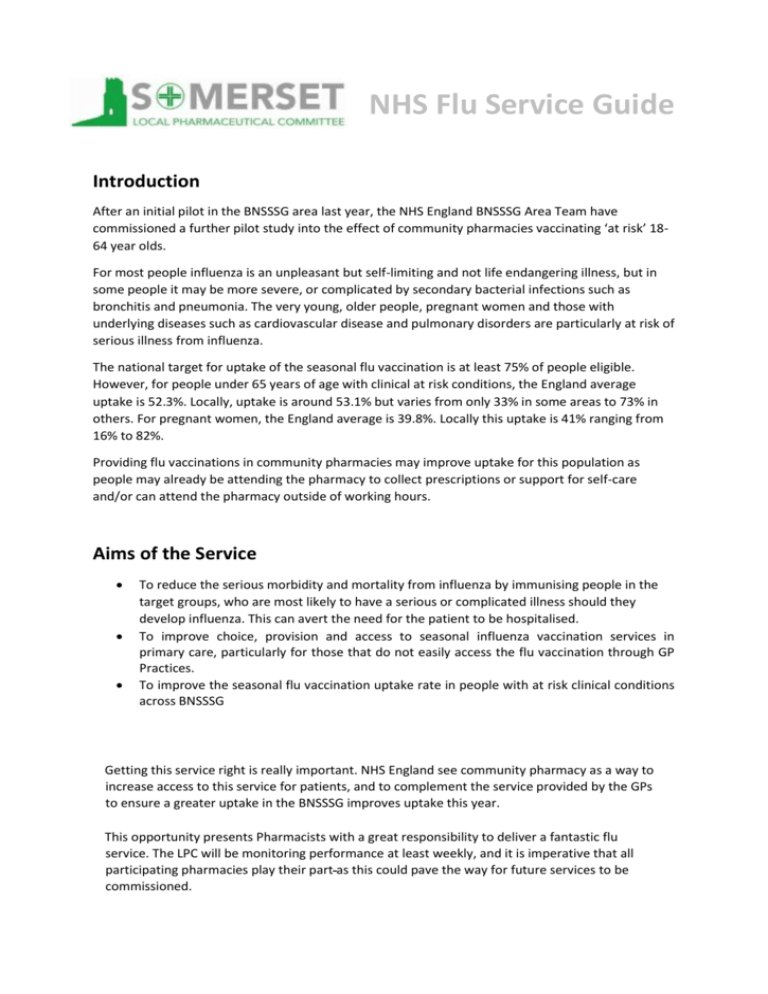
NHS Flu Service Guide Introduction After an initial pilot in the BNSSSG area last year, the NHS England BNSSSG Area Team have commissioned a further pilot study into the effect of community pharmacies vaccinating ‘at risk’ 1864 year olds. For most people influenza is an unpleasant but self-limiting and not life endangering illness, but in some people it may be more severe, or complicated by secondary bacterial infections such as bronchitis and pneumonia. The very young, older people, pregnant women and those with underlying diseases such as cardiovascular disease and pulmonary disorders are particularly at risk of serious illness from influenza. The national target for uptake of the seasonal flu vaccination is at least 75% of people eligible. However, for people under 65 years of age with clinical at risk conditions, the England average uptake is 52.3%. Locally, uptake is around 53.1% but varies from only 33% in some areas to 73% in others. For pregnant women, the England average is 39.8%. Locally this uptake is 41% ranging from 16% to 82%. Providing flu vaccinations in community pharmacies may improve uptake for this population as people may already be attending the pharmacy to collect prescriptions or support for self-care and/or can attend the pharmacy outside of working hours. Aims of the Service To reduce the serious morbidity and mortality from influenza by immunising people in the target groups, who are most likely to have a serious or complicated illness should they develop influenza. This can avert the need for the patient to be hospitalised. To improve choice, provision and access to seasonal influenza vaccination services in primary care, particularly for those that do not easily access the flu vaccination through GP Practices. To improve the seasonal flu vaccination uptake rate in people with at risk clinical conditions across BNSSSG Getting this service right is really important. NHS England see community pharmacy as a way to increase access to this service for patients, and to complement the service provided by the GPs to ensure a greater uptake in the BNSSSG improves uptake this year. This opportunity presents Pharmacists with a great responsibility to deliver a fantastic flu service. The LPC will be monitoring performance at least weekly, and it is imperative that all participating pharmacies play their part as this could pave the way for future services to be commissioned. Preparation for the Service The following pointers may help you in preparing for the service: Create demand for the service by: Advertising the service alongside your private service. Have you got posters up? Take bookings early Make bookings for times of the day in which it won’t affect your prescription business. Maximise the opportunity for vaccinating patients: Offer the service for the majority of your opening hours, including evenings and weekends Mark suitable patient’s prescriptions like you would for MUR/NMS patients Engage the WHOLE team, including counter staff to maximise conversations about the service with patients. Dispensers should know which drugs could indicate a suitable patient to flag for the service. Ensure the WHOLE team know the difference between your private and NHS services to avoid confusion. Housekeeping: Has the training record and signed PGD been returned to the Area Team for each participating Pharmacist? Have SOP’s been read by the team? Do you have facilities for the disposal of sharps and for their collection? Do you have space in your fridge for the vaccines? Does your consultation room look clean and clinical? If not, is it time for a tidy? Do you have your access details for PharmOutcomes in a location where ALL staff know about in case of a different Pharmacist offering the service? Have you accessed and familiarized yourself with PharmOutcomes to ensure you know how to work the program? If your consultation room doesn’t have a computer, is there a tablet or lap-top that could be used for consultations on PharmOutcomes? If not, do you have a copy of the PharmOutcomes form to capture data for later transposal onto PharmOutcomes? How to Target the Correct Patients The groups listed below are eligible for a flu jab within the scope of this service. There are also pointers to help target these people in your pharmacy for each group. Respiratory Disease Conditions Included: Asthma that requires continuous or repeated use of inhaled or systemic steroids or with previous exacerbations requiring hospital admission, Chronic obstructive pulmonary disease (COPD) including chronic bronchitis and emphysema, Bronchiectasis (chronic infection of the bronchi and bronchioles leading to permanent dilation of these airways), Cystic fibrosis, Interstitial lung fibrosis, Pneumoconiosis (results from the excess inhalation of dust e.g. from coal), Bronchopulmonary dysplasia (affects mainly premature babies so unlikely to be seen!) What to Look Out For: Steroid inhalers, Anticholiergics (tiotropium, ipratropium…), Long acting B2 agonist, Montelukast, Theophylline, Nebules, Steroid tablets, For cystic fibrois… Creon capsules, ursodeoxycholic acid, antibiotic nebulisers? Patients just taking a short acting B2 agonist are not included. Chronic Heart Disease Conditions Included: Congenital heart disease Hypertension with cardiac complications Chronic heart failure Individuals requiring regular medication and/or follow-up for ischaemic heart disease. What to Look Out For: Congenital Heart disease - Patients with stents, replaced valves, ‘hole in the heart’ – not generally medically treated but may mention it to you or a colleague in passing. Chronic heart failure – o Symptoms include dyspnoea, especially during and after exertion (but even at rest if severe), wheeze, cold extremities to name but a few. o Treated with combinations of loop diuretics, ACE-inhibitors, β-blocker, spironolactone, digoxin. Ischaemic heart disease (clogging of the arteries) - angina medication i.e. regular GTN, nitrates, β-blockers, calcium channel blockers etc. Complications of hypertension – retinopathy, haemorrhage, kidney problems (mainly covered in other groups). Chronic Kidney Disease Conditions Included: Chronic kidney disease at stage 3, 4 or 5 Chronic kidney failure Nephrotic syndrome (a combination of proteinuria, albuminaemia and oedema.) Kidney transplantation What to Look Out For: Drugs including: o Vitamin D analogues including alfacalcidol, o Phosphate binders (eg. Calcium, lanthanum, sevelamer, aluminium hydroxide), o High doses of loop diuretics, o Immunosuppressants (e.g. ciclosporin, tacrolimus, azathioprine, mycophentolate), o ACE-inhibitors or angiotensin II receptor antagonists are used in nephrotic syndrome to address proteinuria as well as furosemide/spironolactone Chronic Liver Disease Conditions Included: Cirrhosis Biliary atresia (usually a birth defect or occurs after transplantation so unlikely to come across) Chronic hepatitis What to Look Out For: Drugs including: o Colestyramine, o High dose ursodeoxycholic acid, o Penacillamine, o Spironolactone, o Loop diuretics, o Vitamins i.e. vitamin B, pyridoxine, fat soluble vitamins (A,D,E,K), o Drugs to treat alcohol dependence e.g. disulfram, acamproste, chlordiazepoxide. These don’t necessarily indicate a chronic condition but there may be one underlying. Substance misuse patients. This group may have a dependence on alcohol leading to a chronic liver condition. There possibly could be the presence of hepatitis too in injecting drug users. If injecting people with hepatitis please ensure you have an absolutely robust needle stick injury protocol in-place, and Pharmacists should think about hepatitis B vaccination prior to commencing the service. Chronic Neurological Disease Conditions Included: Stroke Transient ischaemic attack What to Look Out For: Aspirin Clopidogrel Dipyridamole NOT ANTICOAGULANTS!!! People on anticoagulant therapy are excluded from the service. Diabetes Mellitus Conditions Included: Type 1 diabetes Type 2 diabetes requiring insulin or oral hypoglycaemic drugs Diet controlled diabetes Immunosuppression What to Look Out For: Anyone suffering from an immunosuppressive disorder e.g: o HIV o Patients undergoing chemotherapy o Bone marrow transplant o Myeloma o Disorders affecting the immune system eg IRAK-4, NEMO Anyone taking the following medication: o Azathioprine, mycophentolate, ciclosporin, cyclophosphamide, tacrolimus, methotrexate, high dose steroids (equivalent to 20mg prednisolone) for more than a month: Prednisolone 20mg is equivalent to: 3mg Betamethasone 100mg Cortisone Acetate 24mg Deflazacort 3mg Dexamethasone 80mg Hydrocortisone 16mg Methylprednisolone 16mg Triamcinolone Asplenia or Dysfunctions of the spleen What to Look Out For: People with no spleen Any dysfunction of the spleen Coeliacs – Having coeliac disease can cause the spleen to work less effectively. On handing out gluten free products, check whether they have a fully working spleen. Homozygous sickle cell disease – the spleen can become enlarged due to misshapen red blood cells. Pregnant Ladies What to Look Out For: Any stage of pregnancy (1st, 2nd or 3rd trimester) Check for exemption status ‘D’ on the back of prescriptions Pregnant ladies coming to the pharmacy for healthcare advice - Ensure counter assistants know about the flu service for pregnant ladies so they can ask when serving customers. Likely to be unsure of whether to have vaccine – o Do I need it? - There is good evidence that pregnant women have a higher chance of developing complications if they get flu, particularly in the later stages of pregnancy. One of the most common complications of flu is bronchitis, which if serious can develop into pneumonia. If flu occurs during pregnancy, it can lead to premature labour or a low birth weight. It can even lead to stillbirth or death in the first week of life. o Is it safe? - Studies have shown that the flu vaccine is safe during any stage of pregnancy, from the first few weeks up to expected due date. The vaccine doesn’t carry risks for either mother or baby. It also poses no risk to women who are breastfeeding. o How is my baby affected? - Women who have had the flu vaccine while pregnant also pass some protection on to their babies, which lasts for the first few months of their lives. Informal (unpaid) Carers Must be the main carer of an elderly or disabled person. Must not be paid for this work, however may be in receipt of carer’s allowance If they were to fall ill the welfare of the person they care for may be at risk. Could prevent ‘flu from passing to the vulnerable. Hard to know whether they are a carer or not.
